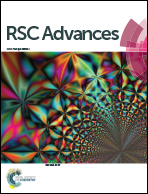Evaluation of polyacrylic anion exchange resins on the removal of Cr(vi) from aqueous solutions
Abstract
This study evaluated the multi-cycle Cr(VI) removal performance of four polyacrylic anion exchange resins (D730, D314, 312 and 213) with different functional groups and porosities based on a fixed-bed column operation. Particular emphasis was given to the effect of oxidation fouling on the ion exchange properties and performance of polyacrylic resins. The functional groups had significant effects on the exchange capacity, adsorption rate, regeneration efficiency, and oxidative stability for Cr(VI) removal. Oxidation fouling on the polyacrylic resins had a significant influence on the removal of Cr(VI). After a 10-cycle operation, due to the oxidation of resins, the adsorption capacities of D730, 213, D314 and 312 resins decreased by 19.8, 21.7, 13.4 and 15.3%, respectively. The results of the Fourier transform infrared rays (FT-IR) analyses showed that the cleavage of C–N and C–C bonds occurred on the polyacrylic resins during the Cr(VI) removal process, indicating the degradation of the resin functional group and matrix. This work provided an understanding of exchange behavior and oxidation fouling of Cr(VI) on different polyacrylic resins, and should result in more effective applications of ion exchange for Cr(VI) removal from solutions.


 Please wait while we load your content...
Please wait while we load your content...